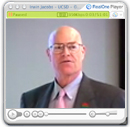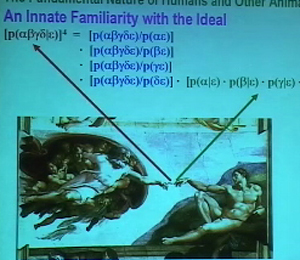Pioneer in Artificial-Intelligence Software Devises New Theory of Cognition
3.10.05 -- A leading expert in artificial intelligence and neural networks who coined the term 'data mining' in the 1980s argues that cognition in humans and many animals occurs in a very different, non-algorithmic and less complex way than has been widely assumed until now.
|
Robert Hecht-Nielsen, an adjunct professor in electrical and computer engineering at the University of California, San Diego's Jacobs School of Engineering, has also been a vice president of R&D at Fair Isaac Corporation since the company acquired a software firm he co-founded, HNC Software. Earlier this week he outlined his theory of the fundamental mechanism of cognition in a seminar on the UCSD campus, and details appear in the February issue of the journal Neural Networks , in an article titled "Cogent Confabulation."
The Hecht-Nielsen theory posits that all aspects of cognition - seeing, hearing, understanding, planning and so on - are carried out using a single type of knowledge (antecedent support) and a single information processing operation called 'confabulation' which is carried out between the brain's cerebral cortex and thalamus. The scientist's theory hypothesizes that confabulation is the only information processing operation used in cognition. The theory also explains the cognitive mechanism by which behaviors (thoughts and movements) are launched, moment by moment, throughout the day.
"Adults possess billions of individual items of knowledge, and the rate of acquisition must exceed one item per second, which is totally inconsistent with current views of human nature," said the mathematician, who is affiliated with UCSD's Institute for Neural Computation, as well as the California Institute for Telecommunications and Information Technology. "How many times has your child come home from school and, when asked what he or she learned today, said 'nothing.' But that's not true. They have probably accumulated hundreds of thousands of items of knowledge, and when we sleep, we consolidate that knowledge. No wonder we need eight hours of sleep!"
|
Hecht-Nielsen noted that the common method used in search engines, data mining and drug trial analysis - maximum a posteriori probability - is not the mechanism of cognition. "Humans and animals don't do this," he argued. "Instead, animal cognition maximizes cogency, and in a non-logic environment, cogency maximization implements what I call the 'duck test': if a small animal waddles like a duck, swims like a duck, quacks like a duck and flies like a duck, we conclude that it is a duck because that is the conclusion which most strongly supports the probability of the assumed facts being true."
To validate his hypothesis, Hecht-Nielsen and his colleagues demonstrated the use of confabulation for language generation. Some 8,000 books worth of English-language text were streamed through a computer-based architecture, and when two consecutive sentences within a paragraph seemed topically coherent using a simple thought process, they were marked with symbols and linked. "After a few days of 'reading,' the confabulation architecture had accumulated billions of individual knowledge links," said Hecht-Nielsen. "These items of knowledge along with confabulation were then used to carry out the continuation of a sentence based on the first three words alone, or the first three words and knowledge of the previous sentence."
"In short," he concluded, "brains carry out cognition using a simple, universal, information-processing operation - confabulation - in concert with vast amounts of accumulated knowledge of a very simple kind."
The Hecht-Nielsen theory could have profound implications for medicine, philosophy, social science, education, child development and other areas. The average human adult possesses many billions of usable items of knowledge. In announcing his theory, Hecht-Nielsen noted that he and his colleagues have been working on it for the past 20 years, with strong support from Fair Isaac, where he maintains his lab. Fair Isaac vice president Joseph Milana was on hand for the announcement. "We are proud of the work that Robert has accomplished under our sponsorship," said Milana. "Fair Isaac has a long tradition of supporting pure research. His team is one of a number of groups that Fair Isaac supports without expectation of any immediate commercial application but whose primary goal is the advancement of fundamental knowledge."
So what are the implications of the new theory for software makers? "The character of people working in software, at least those working on cognitive systems, will alter substantially," said Hecht-Nielsen. "People from the communications department or philosophy will be more useful for building these systems than engineers who know how to program in C or Java. The utility of algorithmic programming in this kind of a pursuit will be marginal, because the new 'brains' will be machines with endless amounts of time, that will be able to de-bug endlessly."
Members of Hecht-Nielsen's team on hand for the announcement included project coordinator Kate Mark; scientists Robert Means and Syrus Nemat-Nasser; and researcher Luke Barrington. While thanking those colleagues and his family, Hecht-Nielsen also noted the role that his cat Zeus played. "This theory would never have occurred without Zeus," he noted, after showing attendees video clips of the feline in action. "He was the behavioral subject that I observed, and in particular, he taught me that there must be some event that triggers every behavioral event, and it had to be the same in every instance, whether we're thinking, moving, or whatever."
As for his own research agenda, Hecht-Nielsen said he has two goals. The first is to stimulate research by other scientists to disseminate and apply his theory as widely and rapidly as possible. "I am also involved in trying to find out how these little modules work," he added. "Cortical tissue doesn't look like it's broken up into little modules, but it must be functionally divided. Working through that mystery is going to be a tremendous scientific joy ride."
The UCSD Bookstore is preparing a reprint package that will include a copy of the new Hecht-Nielsen article from Neural Networks, the materials presented and handed out at the talk, and a preprint of a forthcoming 89-page book chapter by Hecht-Nielsen entitled "Mechanization of Cognition" which, he said, "is not a description of how cognition was mechanized but instead is a plan for mechanizing cognition." A DVD with the video of Hecht-Nielsen's March 7 UCSD talk (suitable for presentations at seminars and to classes), along with files for some of the documents, will be included in the UCSD Bookstore package.
Related Links
Neural Networks Article [downloadable here]
Fair Isaac Corporation
Media Contacts
Media Contact: Doug Ramsey, (858) 822-5825, dramsey@ucsd.edu


